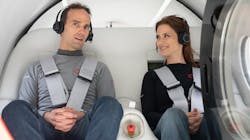Virgin Hyperloop performs first passenger test
Virgin Hyperloop made history Nov. 8 with a 15.5-second run of its test pod, which contained passengers for the first time. Chief Technology Officer and Co-Founder Josh Giegel and Director of Passenger Experience Sara Luchian participated in the test run, which occurred at Virgin Hyperloop’s 500-meter (1,640-foot) DevLoop test site in Las Vegas, Nev.
“When we started in a garage over six years ago, the goal was simple – to transform the way people move,” said Giegel. “Today, we took one giant leap toward that ultimate dream, not only for me, but for all of us who are looking towards a moonshot right here on Earth.”
“Hyperloop is about so much more than the technology. It’s about what it enables,” said Luchian “To me, the passenger experience ties it all together. And what better way to design the future than to actually experience it first-hand?”
The passenger test was performed using a two-seater XP-2 vehicle, that the company says was custom built by Bjarke Ingels Group and Kilo Design (BIG) to demonstrate passengers can safety travel in a hyperloop vehicle. Virgin Hyperloop explains a production vehicle will be larger and seat up to 28 passengers.
“I can’t tell you how often I get asked ‘is hyperloop safe?,’” said Jay Walder, CEO of Virgin Hyperloop. “With today’s passenger testing, we have successfully answered this question, demonstrating that not only can Virgin Hyperloop safely put a person in a pod in a vacuum environment, but that the company has a thoughtful approach to safety which has been validated by an independent third party.”
The testing campaign, from the beginning stages all the way through to the successful passenger demonstration, was overseen by the industry-recognized Independent Safety Assessor Certifer. The company notes the XP-2 vehicle demonstrates many of the safety-critical systems that will be found on a commercial hyperloop system and is equipped with a state-of-the-art control system that can detect off-nominal states and rapidly trigger appropriate emergency responses.
“For the past few years, the Virgin Hyperloop team has been working on turning its groundbreaking technology into reality,” said Sir Richard Branson, founder of the Virgin Group. “With today’s successful test, we have shown that this spirit of innovation will in fact change the way people everywhere live, work, and travel in the years to come.”
About the Author

Mischa Wanek-Libman
Group Editorial Director
Mischa Wanek-Libman is director of communications with Transdev North America. She has more than 20 years of experience working in the transportation industry covering construction projects, engineering challenges, transit and rail operations and best practices.
Wanek-Libman has held top editorial positions at freight rail and public transportation business-to-business publications including as editor-in-chief and editorial director of Mass Transit from 2018-2024. She has been recognized for editorial excellence through her individual work, as well as for collaborative content.
She is an active member of the American Public Transportation Association's Marketing and Communications Committee and served 14 years as a Board Observer on the National Railroad Construction and Maintenance Association (NRC) Board of Directors.
She is a graduate of Drake University in Des Moines, Iowa, where she earned a Bachelor of Arts degree in Journalism and Mass Communication.

